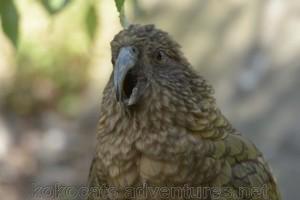Meanwhile back in New Zealand our friends Mike & Helen are taking us for a hike through the forest on Arthur’s Pass in New Zealand (our picture galleries are here and here). We’re quite excited as they are great travel companions and very knowledgeable of the nature around them. They are taking raw eggs and rabbit feet with them. Say what? What voodoo ceremony are we getting involved in here? Should we change our travel plans? It turns out they are helping with nature conservation efforts here and are re-baiting traps for – or against – the so called “pest animals“.
The background for this is that after the isolation of the New Zealand land mass from the once connected Gondwana supercontinent, a very unique set of animals could develop here, most famously various flightless birds. This isolated development is similar to what we saw even more extreme on the Galapagos islands. The only mammal endemic to New Zealand (i.e. found here before humans interfered) was a bat. No foxes or other animals where chasing after whatever was living on the islands of New Zealand at that time. For the lack of predators, flight was not a clear advantage for the birds anymore and birds species developed that simply walked throught the forest, unable to fly (e.g. Kiwi, Weka, Takahe). We met one of the flightless kiwi birds on our very first day here in a wildlife park where the kiwis had a “night enclosure” as they are nocturnal animals. In the darkness in between sandpit, pond and bushes you suddenly spot a large fluff-ball runnig back and forth, sniffing loudly. A very unusual appearance. (Two weeks later we braved a very dark and rainy night to walk into the forest at St. Arnaud with just a small red light to listen into the woods. And we actually heard two kiwis call! We also identified the call of some “Moreporks” and went to bed as two very happy campers.)
With the arrival of humans on New Zealand however, the story of these unique birds took a change for the worse. As with the humas there came dogs, cat, rats, ferrets, possums, rabbits and more. All of these (including the humans) can and will kill a bird hopping for cover without much trouble or eat their eggs as a delicacy. Sheep and cows were brought over by early settlers to provide meat, wool and milk. But of course their pastures once where the habitats of the New Zealand animals. They might also step into nest. Cats and dogs came as pets or sheep dogs – but will happily chase after a flightless bird. Rats somehow always get on land when settlers arrive by boat and are extremely clever and destructive. Rabbits and hedhogs arrived as well. Ferrets and stoats were actually introduced specifically to help fight the rats and rabbits once their detrimental effect had been noticed. This turned out to be a very bad decision, as ferrets and stoats can very efficiently hunt birds and will get into nests killing eggs, young birds and the parents.
Various bird species have already vanished and the numbers of the remaining ones are going down dramatially. The introduced species have been highly successful in populating the islands and enjoying the bird-and-egg diet without predators on their own.
Efforts are underway at verious places now to safe the native birds:
- Breeding programs are trying to increase the numbers of animals, e.g. we saw some for kiwis and rescue stations for penguins.
- Small isolated islands and large areas on both main islands are fenced in and are kept “predator-free“, e.g. Zealandia in Wellington, a full list is here.
- But getting rid of the pest animals in the wild is much harder than it was introducing them.
Here the trapping in the wild comes into play. Our friends help to build and maintain trap-lines up and down the mountains to stop the pest animals in their path and give the birds an area to live and breed. You might find triangular markers in bright colors on the trees and a trap like the one below in the forest. There are thousands of these in the country and they depend on the DOC (dep. of conservation) and volunteers to be maintained. They define where to trap, optimize the design of the trap and test which baits works best. Results are recorded in a database, some other info on these pages.

A trap with egg as bait
These efforts are so intense that every visitor will see some of these traps when walking through the forests and that New Zealand is a big consumer of animal poison, e.g. purchasing 80% of the 1080 pesticide against possums. Most traps we came across were kill-traps however and snapped close with a loud bang. As our friends told us, this led to interesting observations: The mountain parrot Kea, one of the endagered species, is so clever and playful that it is able to trigger some of the simpler traps. It uses a small stick for this and apparently enjoys the loud noise it makes – and of course also renderes the trap useless afterwards, so they had to be re-designed.

The clever Kea
This is an ongoing battle with unknown outcome. For some species it might come too late, others are showing signs of recovery. It’s also a very interesting battle to think about, as it has so many layers and possible interconnections. Just like the real world.